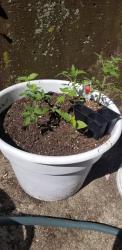IntheHotofTexas has given us all a lot of good information and advice. Thank you!
bonsai_ben, I think you are underestimating the amount of water your plants need, and I agree they should be transplanted into clean pots that give their roots a little more room to grow. As they mature, they will likely have to be repotted into successively larger containers at least 2-3 times. They would also benefit from some food. Transplant with a good soil and some well rotted compost, and maybe give them a bit of fertiliser now, too, to help them acclimate. Compost is black gold, but it works its magic very slowly. Do not apply fertiliser during daylight hours, though. The same is true for any sort of pesticide that you may need to use at some point.
It is very, very hot where I live, and even though most of my plants in my garden face east, I have to water them at least twice per day, more from July through September. Any plant that sits in direct sun 4-6 hours a day, especially one in a plastic pot that was potted with a lightweight soil designed to drain well and fast, is just baking in the sun on your veranda. At the nursery, they were watered every single day remmber.
The plants draw up the water you give them that does not immediately drain out from their pots, but a lot of it is lost to evaporation from the soil, too. They are losing moisture from draining and evaporation. You think you are giving them plenty of water, but I bet they are using up one watering well before end of day each day because they are in direct sunlight the entire time. You can stick your finger down into the soil to feel how much moisture is in it still, but I think you can just look at the plants and see that they are too dry. Plants grown outdoors have different needs than houseplants. Indoor plants may be fine with once a week watering, but outdoor plants are a different matter altogether.
I suggest you repot them in larger clay pots with a stone or something similar inside the pot to cover the hole so that your water and soil do not drain out. Clay pots are very porous, so you water thoroughly and just by looking at the pot you can see how much the soil inside has dried out. If the pot looks wet on the outside, the soil inside still has moisture. If the pot looks dried out, then the soil is either mostly dried out or completely dried out.
As IntheHotofTexas suggested, some sort of sun block screen may be helpful, too. Remember, your plants are not only getting several hours of direct, very hot sun, but they are getting the ambient heat from what I presume is a concrete floor of your veranda where they sit and/or hang above. They would also get a lot of ambient heat from the building and any iron railings, etc. That is a fantastic amount of heat for several hours a day. They are baking out there between the direct sun and the ambient heat in their surroundings. If you doubt how much heat is stored in the concrete, brick, or iron railings, walk outside in your bare feet onto the concrete after 4-5 hours of direct sun and see how hot is the ground.
I know you can turn this around, but you may have sacrificed some plants during your learning curve. I find I make mistakes because in my enthusiasm, I often plunge ahead with something instead of researching it first, asking advice from those experienced in an area, and then getting all of my ducks in a row so that I can proceed in a systematic, methodical way. Perhaps that is what you have done, too?
Good luck and let us know what you did and how it worked so we can all learn from this, too!
